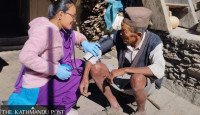Health
Funds shortage hits plan to expand nutrition rehabilitation centres across the country
Nepal’s Sustainable Development Goals target on nutrition is unlikely to be met, health officials say.
Arjun Poudel
Last month, health workers serving at Byans Rural Municipality of Darchula district carried out an assessment of nutrition status in children under five years of age.
Among 903 children of the said age group in the rural municipality, which is one of the remotest areas lying in the northern-western corner of the country, 83 were found malnourished.
“Of them 20 were suffering from severe acute malnourishment and 63 were moderately acute malnurished,” Mukesh Kunwar, a health worker serving at the rural municipality, told the Post over the Phone from Darchula. “We referred malnourished children to the nutrition rehabilitation homes.”
However, most of the country’s hospitals do not have nutrition rehabilitation centres.
The Ministry of Health and Population has a policy to set up 10-bed nutrition rehabilitation centres at all hospitals having 50 beds but only 25 hospitals across Nepal have such centres.
And what is concerning is the Health Ministry’s plan to set up such centres at five hospitals in the current fiscal year has been hampered by the lack of funds.
Doctors say children suffering from severe acute malnutrition should be admitted to the hospital first and then treated at a nutrition rehabilitation centre until their weight becomes normal. Mothers or caregivers of the malnourished children are taught ways to cook and feed children at such centres.
“No rehabilitation centre has been set up in any hospital so far this year,” Lila Bikram Thapa, chief of the nutrition section at the Family Welfare Division of the Department of Health Services, told the Post. “We are planning to set up two hospitals.”
Malnutrition has been dubbed Nepal’s “silent crisis”.
The government aims to reduce the stunting rate from the existing 36 percent to 24 percent by 2025, and to 14 percent by 2030, in order to meet Sustainable Development Goals.
However, officials serving under the Health Ministry concede that it is impossible to meet the target, as the problems have been exacerbated of late.
“We have not said this publicly but the fact is we are not in line to meet the Sustainable Development Goals target,” Thapa admits. “We cannot predict when this target will be achieved but the latest indicators are not satisfactory.”
According to the Multiple Indicator Survey-2019, the nutrition condition of the country worsened long before the pandemic started.
The report showed that 12 percent of children under five suffer from wasting. Wasting or low weight for a particular height is an undernutrition condition, which is a strong predictor of mortality among children under five, according to the UN health agency. Wasting in children is associated with a higher risk of death, if not treated properly.
Less than 10 percent of children under five were suffering from wasting, according to the Nepal Demographic Health Survey-2016.
The 2016 survey shows that 36 percent of children under five years of age suffer from chronic malnutrition (stunting or low height for weight).
Another 27 percent are underweight and one percent of the children are overweight, according to the survey.
It is estimated that the Covid-19 pandemic has made the matter worse. Several nutrition rehabilitation homes have been shut down and converted into quarantine centres, and isolation facilities, which risked the lives of severely malnourished children.
The problem might be more severe in the far-flung villages and hinterlands, which were affected not only by the epidemic, but also by chronic food shortages, say nutritionists.
Nutrition has a direct link with overall national development, said Kedar Parajuli, former chief of the Nutrition Section at the Family Welfare Division. “Without addressing the problems, we cannot achieve several other goals—which ultimately affect the country’s overall growth.”
According to Parajuli, there are over 1.2 million cases (children under five) of severe acute malnutrition in communities. Of them, 20,000 children are estimated to have been suffering from severe acute malnutrition and the rest are cases of moderately acute malnutrition.
Authorities concerned have been focussing on the treatment of severe acute malnutrition cases only but chances of moderately acute malnutrition to be severe is very high, according to Parajuli.
“Focus should be on preventing cases of severe acute malnutrition,” said Parajuuli. “For that, measures should be launched to prevent children from being moderately acute malnourished.”
It is estimated that 53 percent of the total deaths of children under five years are associated with malnutrition in Nepal.
Nutritionists say that the approach of the authorities to view malnutrition only as a health issue is problematic.
“Malnutrition is the consequence of many other factors, which need to be addressed first,” said Dr Keshab Bhattarai, a nutrition scientist.
“Without addressing the food crisis, poverty, water and sanitation issues, and ensuring timely treatment, the problems cannot be lessened.”




 8.12°C Kathmandu
8.12°C Kathmandu














